Koreans do things differently when it comes to diet and nutrition.
I’m going to talk about why Koreans are skinny and the healthy habits they have.
I’ll share fun ways for you to add these habits to your daily life.
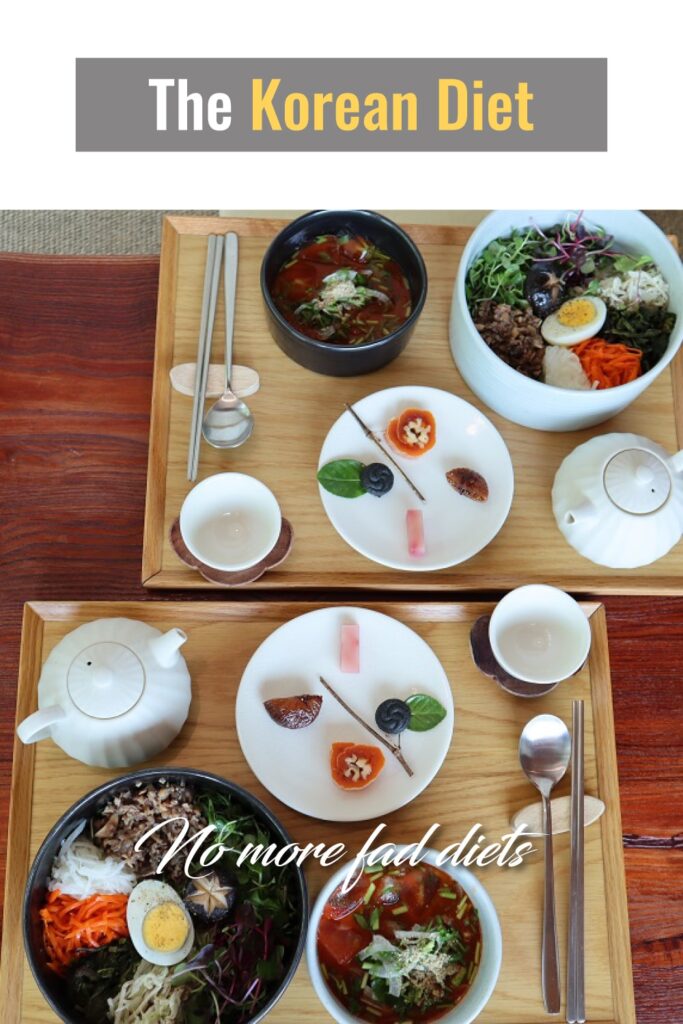
I’ll also go over:
- delicious zero-calorie drinks
- flavorful stews chock full of nutrients
- veggie wraps that add layers of flavor
- tasty guilt-free desserts that are low sugar and often dairy-free
The best part of the Korean diet is that you don’t have to suffer to lose weight.
Key Takeaways
- Drink refreshing and soothing teas instead of sugary drinks.
- Eat mixed rice and grains instead of bread.
- Enjoy ssam or Korean veggie wraps.
The Korean diet consists of grains, vegetables, seafood, meat, and fruit. Traditional meals have four elements: rice, savory soups, kimchi, and banchan (side dishes).
Korean cuisine contains no dairy such as milk, butter, and yogurt. Natural sugar from fruit (pears and plums) was used as a sweetener before industrialization.
Koreans eat a lot and they eat well. Mukbang (먹방 or “eating show” on YouTube) fans already know this.
Traditional Korean cuisine offers a balanced diet free of sugary or fatty foods and a low amount of red meat. You can expect healthy ingredients like soybean paste, fresh vegetables, garlic and chili pepper flakes.
The most surprising thing visitors to Korea or K-town notice is that things taste good without using cream, butter, lard, oil, sugar or even meat. Mmm, all the fun stuff right?
The Korean diet has stayed mostly the same for a few thousand years. (If it ain’t broke, don’t fix it!) The naughty things I mentioned above were reserved for the king, and dairy wasn’t a thing until a few decades ago.
So people had to figure out how to cook without fancy ingredients.
Fast forward to today and they’ve pretty much perfected it.
Most Korean dishes are based on healthy whole ingredients and a variety of low calorie spices to add flavor. (As long as you’re not allergic to garlic. We use A LOT! It’s pretty much our substitute for butter.)
The Korean dietary patterns changed the most recently with industrialization and consumerism, but the old ways still work.
1. Refreshing and soothing teas instead of sugary drinks
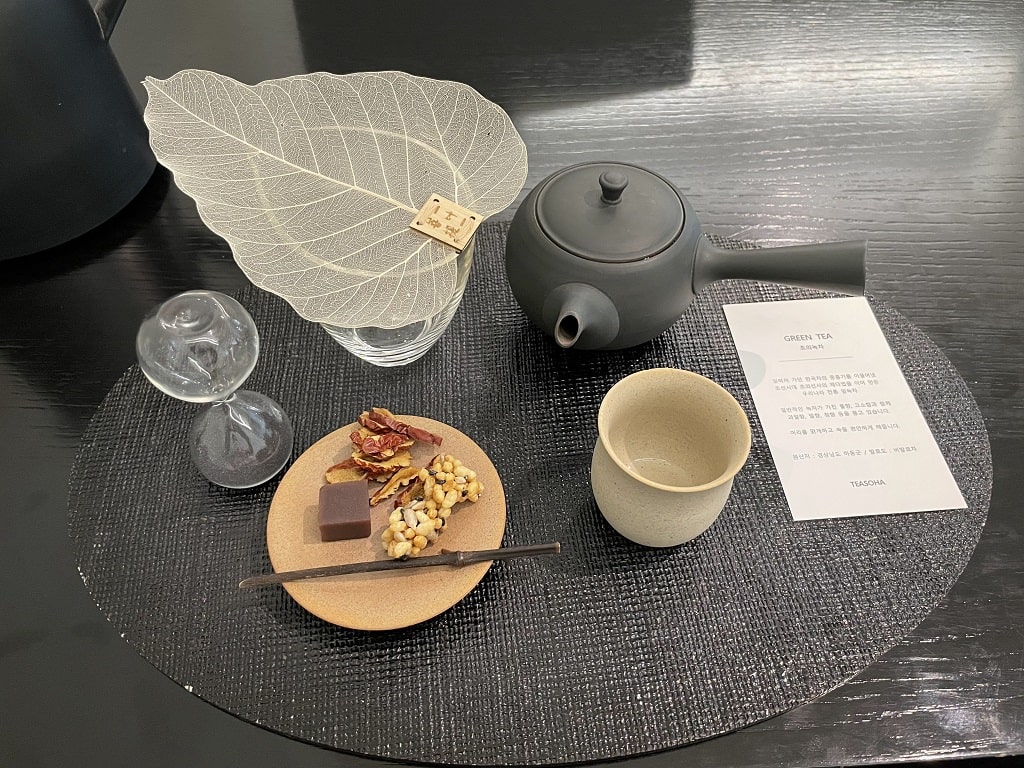
Green tea (녹차) is rich in antioxidants and vitamins, so it’s great for not only dieting but also skin care!
You’ll frequently see this ad copy from Korean companies saying “something contains X times more vitamin C than a lemon”. And yes, green tea contains 5-8 times more vitamin C than a lemon.
Green tea🍵 is most effective when it’s served warm, but you can pop it in the fridge on a hot day for a cool refreshing drink.
- How to Prepare: Brew green tea at a temperature of around 70℃ (158°F) for 20 to 30 seconds.
- Recommended intake: About 2-3 cups a day. (It HAS caffeine, so don’t overdo it.)
- Tip: You can finish washing your face with green tea water, or place cold green tea bags on puffy eyes to reduce puffiness and dark circles in the morning!
But that’s not even the half of it! Korean convenience stores are chock full of tasty zero calorie drinks like:
- Shibchil cha (17차)
- Bori cha (보리차)
- Hoetgae cha (헛개차)
- Ggaman kong cha (까만콩차)
They’re a great substitute for sodas and energy drinks. They even have similar health benefits to green tea.
If you live outside Korea, you can easily make these at home with the right ingredients! Koreans make a huge pitcher of bori cha and keep it in the fridge during summer. Have a tall glass with every meal and you’ll end up eating less naturally.
2. Hearty soups and stews
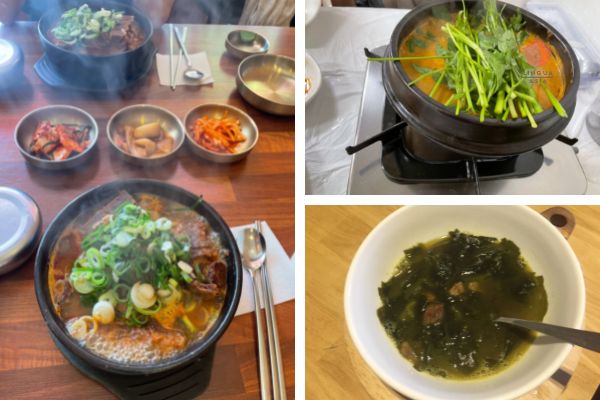
Right: Top: Ori-tang (Duck Stew) & Bottom: Miyeokguk (Seaweed Soup)
Korean meals are often centered on one of the many types of hearty soups and stews. These cover all the healthy food groups and are a great way to avoid weight gain.
My favorite is Ppeyo Haejangguk (뼈해장국), which literally means “bone hangover-cure soup“. As its name suggests, this one is perfect after a long night-out.
You’ll find this dish in K-Town. So meaty, yum! q(≧▽≦q) And functional. You’ll literally feel renewed after having it.
Miyeokguk is another healthy soup that’s easy to cook at home. All you need is dried seaweed (미역), which is available at a Korean grocery store, beef cubes, soy sauce and sesame oil!
Seaweed is also loaded with Vitamin A, C and E as well as healthy stuff like iodine which great for everything from the Thyroid to the Prostate gland.
I love this one because it’s easy to make anywhere including western countries like the United States and Canada. Miyeokguk is also a birthday soup in Korea, so prepare it for your husband, wife or significant other when you want to impress them.
There’s also
- Kimchi jjiggae (김치찌개)
- Doenjang jjiggae (된장찌개)
- Gookbab (국밥)
- Seolleong tang (설렁탕)
- Mandoo gook (만둣국)
These stews are super filling, delicious, nutritious and low-calorie.
Eating one first thing in the morning keeps me full until dinner time with all the protein and carbs I need for the day. Then it’s just a light dinner and I lose tons of weight.
I love these dishes because I can stay in shape while enjoying my meals and not starving. There are so many types that you can eat them in rotation and never get bored.
3. Healthy side dishes
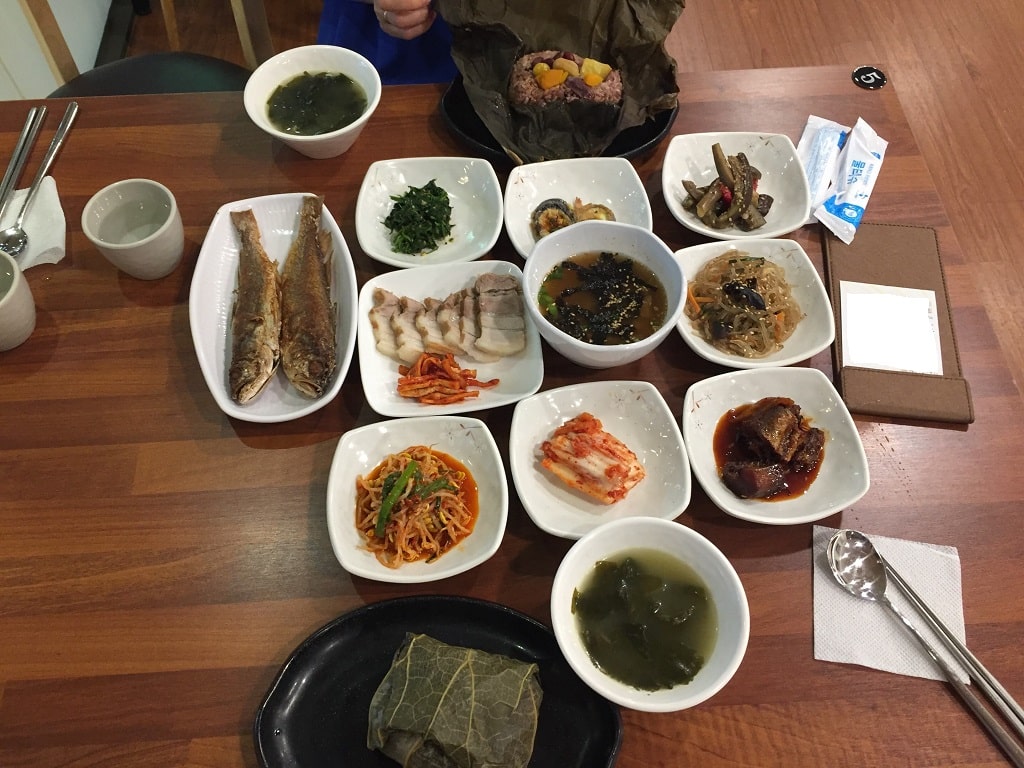
When you eat Korean food, it ALWAYS comes with healthy side dishes. Refills are also free of charge!
Korean side dishes are usually veggies like:
- bean sprouts
- spinach
- zucchini
- potatoes
- green pumpkin
- eggplants
- and of course Kimchi!
Koreans consider meat or fish a “main dish”. But you eat everything together. There’s so much variety that you’re sure to find ones you enjoy.
You can eat as much as you want and not gain weight. The only exceptions are the sweet ones like black beans. If it tastes sweet, limit how much you have. I know, it’s hard. ^_~

4. Veggie wraps

All the fresh veggies are from farm to table, literally!
The grandma running this restaurant picked the veggies from her own garden.
Korean veggie wraps are amazing! They’re the best way to eat your salad and enjoy it without ranch…mmm ranch though.
It’s called Ssam (쌈) and the menu in the photo above is “Ssam Bap (쌈밥)”, literally meaning veggie wrap rice.
If you’re dieting, try a minimal version of ssam bap by placing a spoonful of brown/purple rice with a drop of Ssam Jang (쌈장) on a big leafy veggie.
Tip! It should be a bite-sized, not like a burrito.
One of my friend’s recipes for Tofu Ssam Jang, which is great for dieting is: Add a bit of toasted sesame oil, minced garlic, smashed tofu and chopped walnut to store-bought ssam jang. Mix it all up and eat it with ssam for a delicious low-fat dish!
Korean Diet Pills
Yes… Some Koreans rely on diet pills. I haven’t seen anyone succeed with it though (they all ended up yo-yoing and gaining the weight back). My friends tried pills and the oriental medicine version. I’ve heard the oriental version works better and it doesn’t damage the body much, since it’s made of herbs and roots. If you’re curious, check out 한의원 (oriental medical clinic) at your nearby Koreatown, and ask for 다이어트 한약 (diet han-yak).
5. Whole foods that fill you up
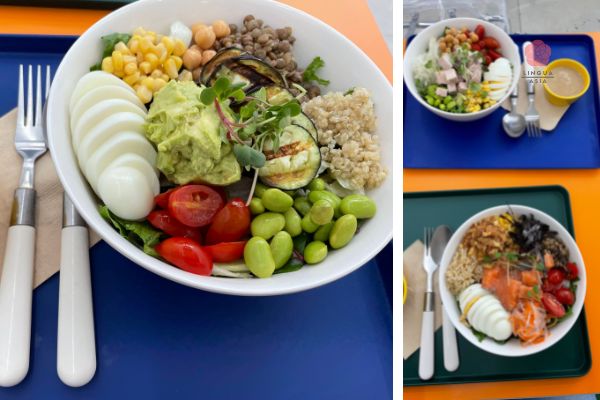
Processed foods became big in South Korea only in the last half century. You can still find tons of whole foods at a bang-at-gan (방앗간) where they sell misutgaru (미숫가루) and toasted sesame oils (참기름). They might not have the fresh-made versions in the states, but ask at your local Korean grocery store.
It’s also common for people to steam goguma (고구마) or sweet potato which is super filling and low calorie. You can find street vendors who sell steamed roots, which are great when you don’t have time for a meal.
For those who live outside Korea, just buy some in bulk and throw them in a rice cooker after washing them. You can also use a brown paper bag and microwave goguma and potatoes.
Carbs being the enemy is the mantra of this century. But not all carbs are created equal. Some are full of fiber and will fill you up to prevent you from eating high calorie foods or snacking.
As I mention elsewhere, rice can be substituted with whole grains. You can even mix white rice with other grains. Fiber is your friend and whole foods are full of them.
Interestingly enough, these grains were for commoners during the feudalism period in Korea. Only nobles could afford white rice. Now, the tables have turned and whole grains are more expensive because they’re healthier and in demand.
Here are a few more whole foods Koreans eat:
- corn (not the best for you, but better than processed snacks)
- black beans
- lotus root
- acorn jelly
- white radish
- wild sesame

6. Rice and grains instead of bread

I LOVE BREAD! But, I try to mix my diet with rice and grains, like bread one day, rice another.
It’s totally fine if you don’t have a rice cooker. One of the life hacks I’ve learned while traveling is that you can simply microwave a covered bowl of rice with water.
Put a plate underneath to catch any overflow! (Make sure to wash the rice and soak it for at least an hour before cooking.)
White rice tastes good, but mixed grain, purple or brown rice is healthier.
When you’re on a diet, the Korean way is to substitute a bowl of white rice with either mixed grain or brown/purple rice, while cutting the portion to half (1/2 bowl).
When Koreans go on an extreme diet, they even cut rice, and substitute it with steamed tofu or konjac rice.
7. Fermented foods for a healthy gut biome
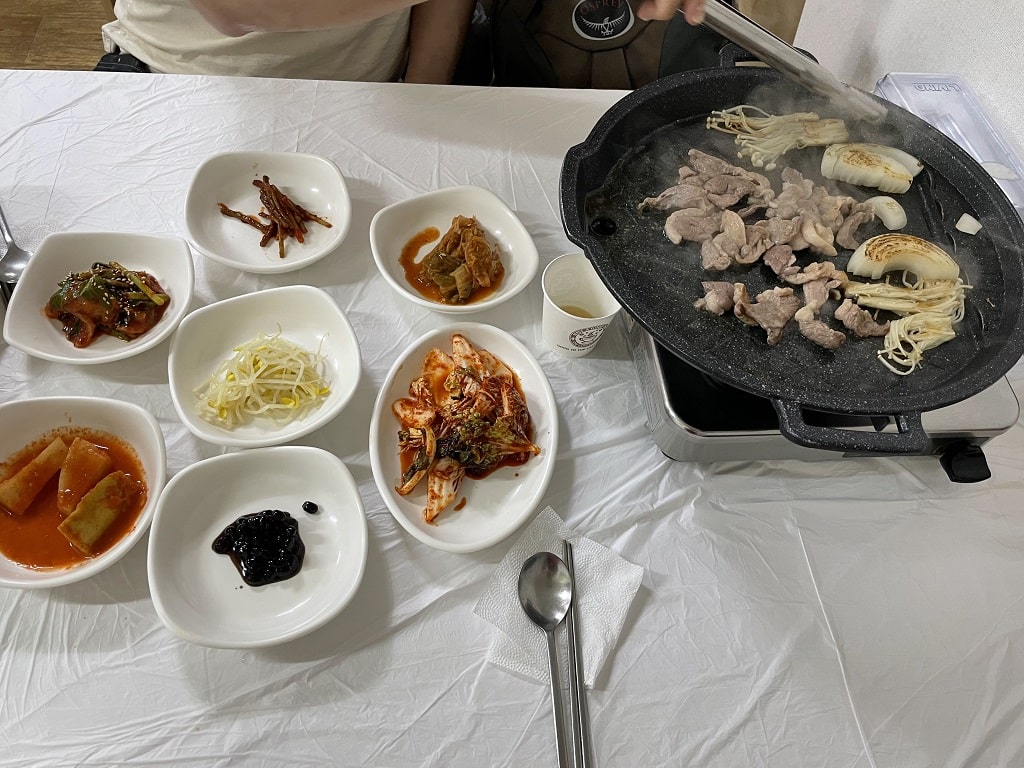
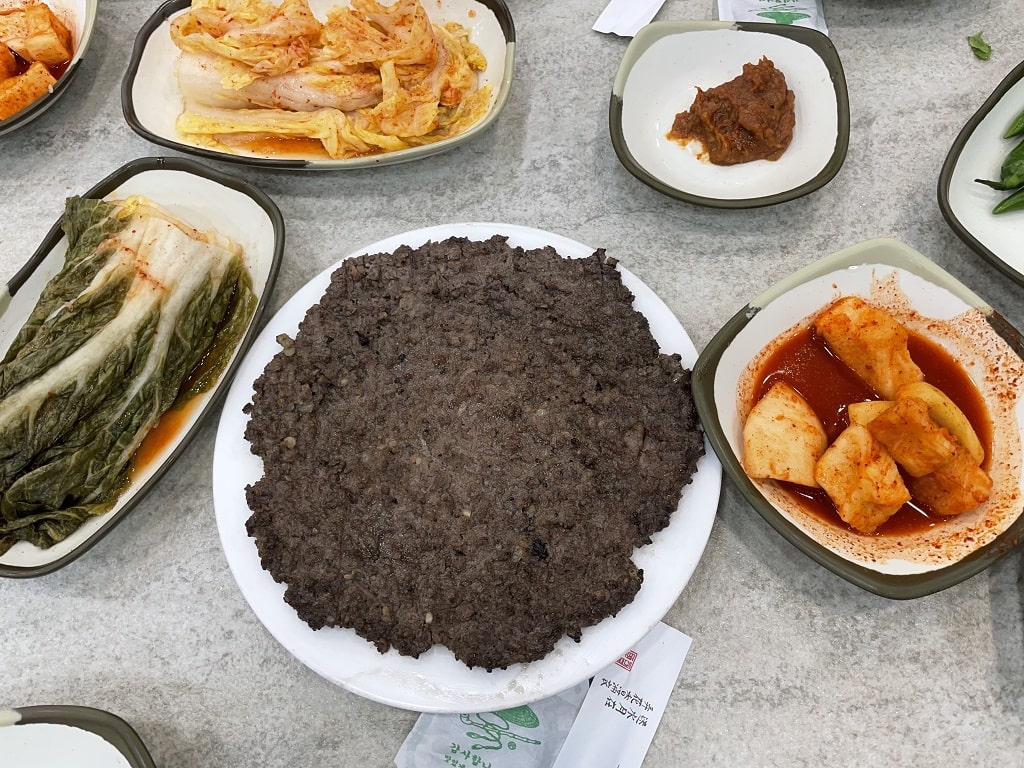
The gut biome affects health in ways we never imagined and probiotics are the key to keeping it happy.
Korean cuisine has heaps of probiotics from fermented dishes like Kimchi, which has hundreds of types. Even the simple meals in the pictures above came with at least 3 types of kimchi.
You may need some time to get used to fermented foods. But once you do, they’re so flavorful and healthy!
Don’t worry if you can’t eat spicy food, I can’t either (I know.. I’m a Korean who can’t eat spicy food. I always introduce myself as a 맵찔이 or map-jji-ri). There’s a non-spicy version: Baek-kimchi (백김치 or white kimchi)!
Here are some more fermented ingredients Koreans use:
- Ganjang (간장)
- Doenjang (된장)
- Cheonggukjang (정국장)
- Ssamjang (쌈장)
- Gochujang (고추장)
- Jeotgal (fermented fish sauce or 젓갈)
These are all flavorful and low-calorie. Koreans also eat fermented fish called hongeo (홍어), but it’s super pungent and intense. They make it easier to consume in Jeolla province though with the right seasoning.
FYI, hongeo is always served at gatherings, parties and even funerals in the Jeolla province.
Meju, the mother of all fermented food in Korea
Most of the fermented ingredients like soy sauce, ssamjang, gochujang, doenjang and cheongkukjang come from meju (메주), which are bricks of dried soybeans. It serves as the base for all of these which are stored and fermented in separate jangdokdae (장독대). Talk about versatility!
These bricks were the lifeblood of Koreans for hundreds of years and helped them survive the winter. My great grandma used to make it at her traditional Korean house. Store-bought ingredients are fine, but nothing beats homemade.
8. Fruits and rice cakes for dessert
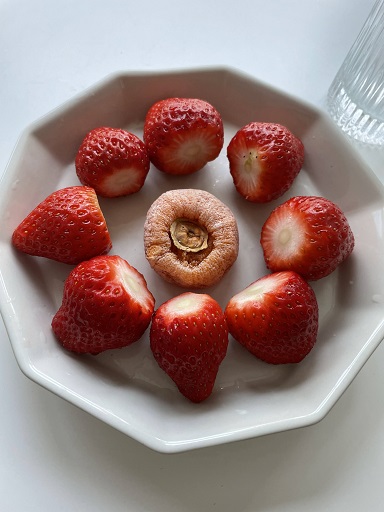
Koreans eat fruit pretty much after every meal. Some fruit may be high in calories, but they’re still better than cookies and cupcakes (I love them too though!).
Dried persimmons are the dessert you didn’t know you were missing. Well-made ones are as addictive as they are healthy.
As featured in the K-drama, Kingdom, only kings or royal family members got to eat gotgam from Sangju, and others could only dream of them (they’re so good, the prince’s guard risked his life by taking one for his pregnant wife).
A little tip to enjoy gotgam in a modern way is to make a 호두곶감말이 (walnut – dried persimmon roll) by slicing dried persimmons open, spreading cream cheese, adding a walnut, rolling and cutting them!
Here are a few other traditional and modern Korean desserts you have to try:
- Yakgwa (약과)
- Yoogwa (유과)
- Tteok (떡)
- Hwajeon (화전)
- Dashik (다식)
- Yeot (엿)
- Gangjeong (강정)
- Hodoo Gwaja (호두과자)
- Bungeo Ppang (붕어빵)
- Gyeran Ppang (계란빵)
- Gyeongju Ppang (경주빵)
- Chalbori Ppang (찰보리빵)
- Hotteok (호떡)
These still have nutritional value and fill you up, so you won’t crave higher calorie sweets or be tempted to snack later.
Koreans also get a rice cake cake (떡케이크) on a special day like birthdays or parents’ day for parents/grandparents as a guilt-free dessert.
9. Home cooked meals
Sadly, restaurants are adding more and more sugar/salt in South Korea. Home cooked meals and banchan are still the best.
The easiest way to eat clean and healthy is to control your sodium and sugar intake. Many Koreans cook most meals at home because it’s cheaper and healthier.
The trick is to meal prep and cook in bulk. You can make a huge pot of doenjang jjiggae, which is similar to miso soup, with delicious ingredients like pork belly and hard tofu.
Add some rice and this can last days while being super cheap and healthy. Make or buy banchan to add variety.
Do this once a week with a different dish and you’ll lose weight naturally.
10. Walking culture
Hiking is a cornerstone of Korean culture. This is no surprise since the country is covered with mountains. You don’t need to drive hours to go hiking in Korea. Locals have 뒷산 (small backyard mountain or hill) in their neighborhoods.
It also helps that half of all Koreans live in or around Seoul, which is surrounded by them.
Public transport is well connected in Korea, so you don’t need a car unless you’re deep in the countryside.
When Koreans eat a lot, we all say “let’s go for a walk to digest”. Yes, we do that.
You can still do the same if you live elsewhere, say in the U.S., where public parks and green spaces are abundant.
11. Delicious healthy diet shakes
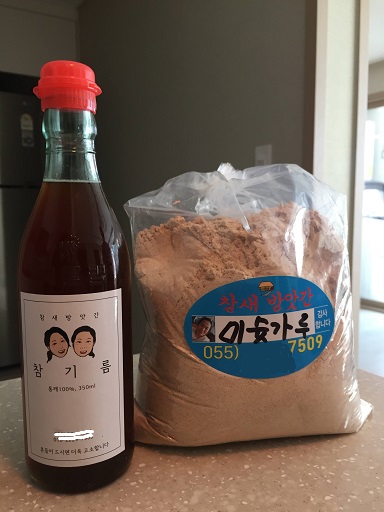
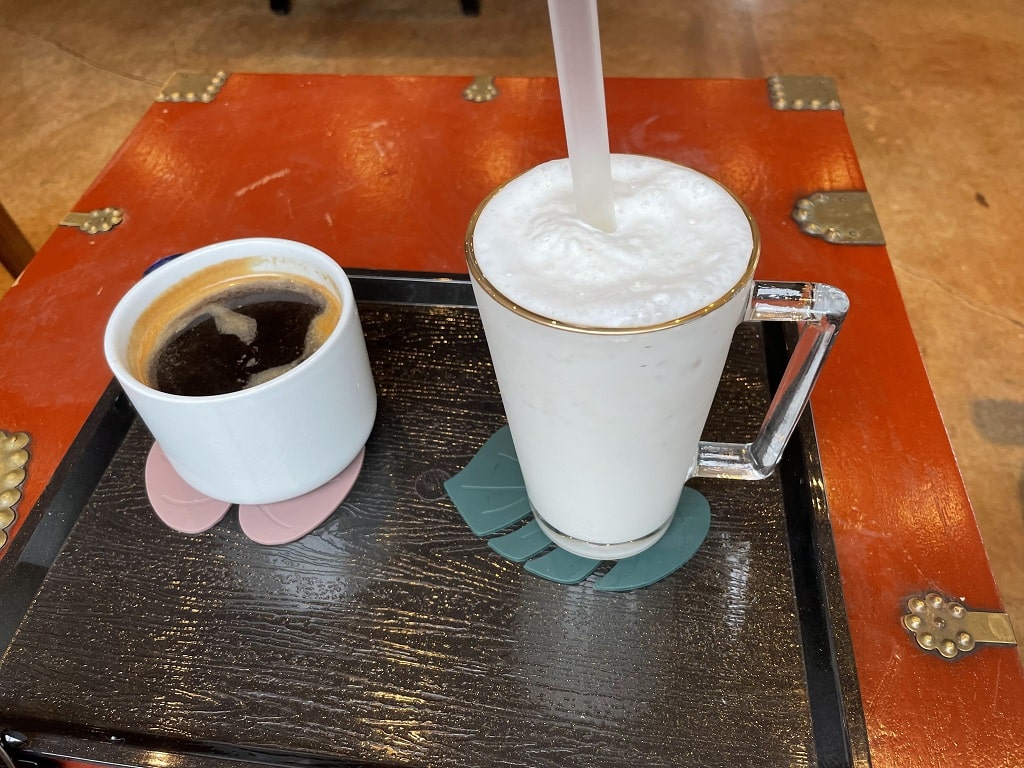
Misutgaru (미숫가루) is a nutty and savory powder you can turn into shake or drink! I’m still wondering why it hasn’t taken off everywhere. It’s the perfect meal replacement drink at night when you don’t want to have a big dinner.
You can get the best ones by visiting a local mill and ordering fresh misutgaru. (They normally put 10-20 different roasted grains and beans, but you can ask for specific types! They’ll freshly roast and grind them for you in 5 minutes.)
It’s super easy to make too. Just add water and/or milk and shake/stir it.
Deodeok (더덕) juice is so yum and healthy. It recently became more famous by Son Dam-bi. She drinks it every morning for brighter, younger skin and as a meal substitute. All you have to do is put deodeok, milk and honey into a blender.
There are other drinks like jeub (즙 or extract) which is made from a variety of fruits, vegetables and roots. They come in little packets and are just great in the morning when you’re in a hurry to get ready.
Bonus! Variety of Korean diet food
There are so many types of healthy but delicious Korean food that work perfectly as diet food.
- Tofu (두부): I love making Inari Sushi (유부초밥), with smashed tofu instead of rice.
- Seaweed (미역): Miyeokguk is highly nutritious.
- Taro (토란): My favorite soup is Taro Soup (토란국) from Jeolla-do region.
- Cabbage (양배추): 양배추쌈 (Ssam with steamed cabbage) is super delicious and healthy! It’s the perfect diet food.
With so much variety, I often forget about them. It’s one of the reasons why I wrote this post, so I can refer to it later. You’ll never get tired of having the same thing.
Negative parts of Korean diet
It’s not all rainbows and sunshine for Korean eating habits; there’s trouble on the horizon. Especially stress eating during the pandemic didn’t help things.
- Spice: Korean dishes can be WAY too spicy. Make sure to tone down the pepper content.
- Fried chicken: You should definitely try Korean fried chicken! But not every day.
- Tteokbokki: Tteokbokki is my soul food, but I can see love handles forming after eating it. Probably because it’s 1,500-2,500 calories per order.
- More sugar added: I have to kind of blame Baek Jong-won (백종원) for this one. He may be a good chef, but he introduces easy recipes to Koreans by adding a lot of sugar to everything.
- Alcohol: Yeah.. Koreans drink a lot, but always with food (안주 or anju). Unfortunately, cutting alcohol is key to losing weight.
- Pork belly: I love samgyeopsal (pork belly)! But I try to limit it to once a month or 2 weeks. My defense is that I eat a lot of ssam (veggies) with it! Korean BBQ was reserved for special occasions in the past, so it’s best to enjoy it sparingly.

Easy Korean diet plan you can use
If you want a weight loss diet the Korean way, just try buying or making one Korean dish a week.
You can still eat what you normally do while broadening your horizons with some new flavors.
Once you’ve found some Korean food you like, you can add more days each week.
The addition of Korean dishes will help you lose weight while enjoying your meals. Just make sure to switch the menu, so you don’t get tired of them. I try to wait at least two weeks before making the same dish twice.
Fried chicken doesn’t count! Trust me, I’ve tried.
Interesting Korean diet plans
I included these because there’s some interest in them. Besides some oddly specific situations like,
- brides getting ready for their wedding
- models getting ready for a show, fitness, fashion or otherwise
- K-pop idols before new singles or albums. This is known as the “K-pop diet”.
- athletes trying to cut weight
I advise against them. You probably don’t want to survive on sweet potatoes and tears for the rest of your life.
More about fitness in Korea
Korean military diet
The Korean army diet is just eating kimchi with cucumber, zucchini, mushrooms, potato and meat banchan on rice every day. You’ll lose tons of weight, but I like other cuisines too much to limit myself to only Korean food.
The North Korean army has a more extreme version of this with mainly rice/maize, kimchi and bean paste. Not a fun way to live.
Korean girl diet
There are many versions of this and they all hurt. They mainly rely on starving yourself by having a huge deficit in calories every day. People get creative with it like just eating grapefruit, strawberries, tomatoes and sadness.
Unless you’re in a girl group, you probably don’t want anything to do with these.
Korean liquid diet
Another unsustainable way to lose weight. You just drink shakes and juice concentrates. If you’re like me, you want to enjoy solid food while you’re still able to.
Korean Jindo diet
This is for dogs, as in what THEY should eat. You feed Jindos pretty much what you’d feed any other dog of that size. Maybe throw in some roasted sweet potato in winter in case they get homesick.
Subscribe for
exclusive info on Korea
FAQ
Why are Koreans so skinny?
The short answer is a combination of low-calorie whole foods and walking. The long answer is intense social pressure and default clothes sizes being extremely small.
Did we miss anything?
Let us know your thoughts or questions about Korean diets in the comments!
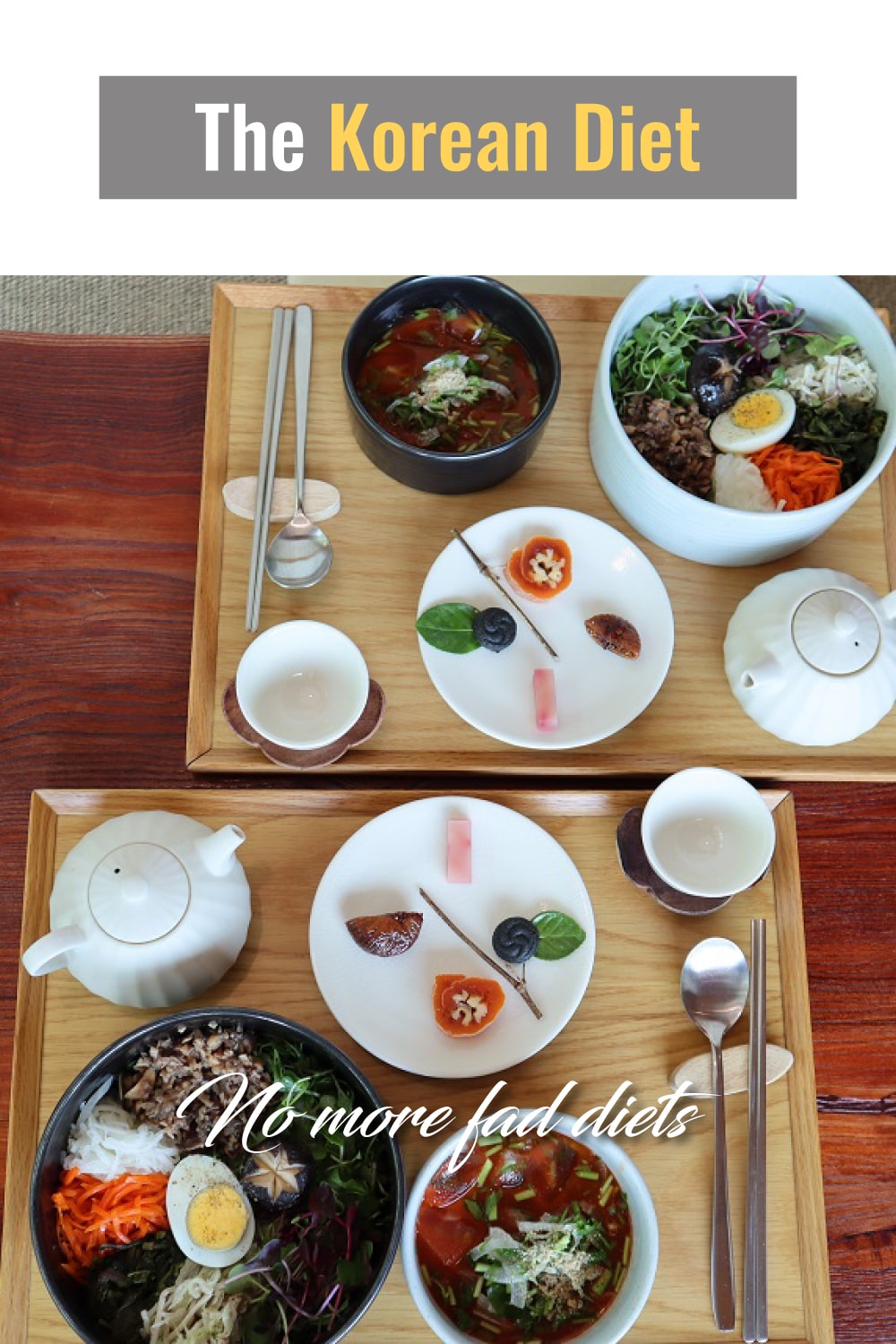




Very informative and enlightening.
Are there any specific Korean diet foodstuffs, Korean herbal medicines that counteract the effects of chronic urban stress such as high blood pressure, bad cholestrol, and being uptight?
Thank you
Hello Basil,
Thank you for the nice comment and question.
I’m not sure about specific ingredients of herbal medicines since doctors of Oriental(Korean) medicine prescribe their own blends.
⁕While taking herbal medicines for 1-3 months, you’ll be asked not to consume flour, alcohol, caffeine, pork, etc. That alone might be the trick:)
In general, Koreans eat tangerines, brown rice, lotus root, blue-backed fish while sticking to a low sodium diet to lower blood pressure and cleanse blood vessels.
Hope you stay healthy!
I would love to see a blog that showed Korean girls daily foods , not fancy restaurant versions but what they actually eat daily.
Hi Christine,
That’s great idea. I’ll try to write another article about what Korean girls usually eat.
In the meantime, Korean girls usually eat 2-3 meals a day, consisting of a bowl of steamed rice, a few side dishes (mostly vegetables), kimchi, soup and a main dish (meat or seafood).
When we go on a diet, we switch from white rice to mixed grain rice and halve the portion. Or, simply eat a boiled egg, steamed sweet potato, salad, etc. for extreme dieting.
I hope this helps!